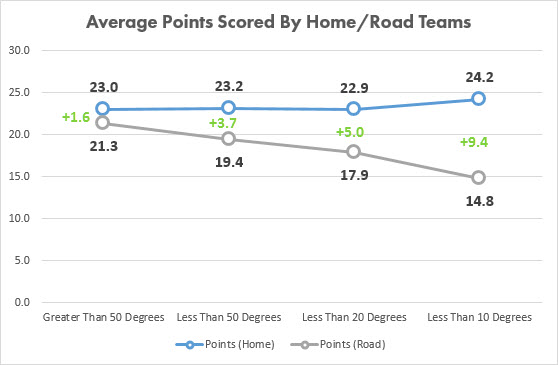
Will it be cold when the Seahawks travel to Minnesota to play the Vikings this weekend? Ya, sure, youbetcha. The current forecast calls for a high of 1 degree on Sunday. Pete Carroll mentioned in his press conference this morning that cold weather can impact handling of the football, which makes sense, but I found myself wondering if there was evidence to support that claim and what other effects I might discover. The results were eye-opening.
The process
The findings
Turnovers
Let’s start with Carroll’s instinct that turnovers increase in cold weather games.
The average number of turnovers in warm weather games was just over three. If you just look at games under 50 degrees compared to games over 50 degrees, the difference appears negligible (3.6 vs 3.2).
However, as you start to lower the thermometer, that ball starts coming loose. Drop the temp below 20 degrees and you see a 42% jump in combined turnovers. Drop it down below 10 degrees, and the turnover rate jumps another 10%, closing in on nearly double the warm weather rate.
Conclusion: If your team is playing a game outdoors in sub-freezing temperatures, expect turnovers to play a major factor in the outcome, even more so than a typical game. The colder the game, the more turnovers should be expected.
Yards gained
There appears to be a modest impact to how many yards offenses gain. Games under 50 degrees saw a 5% drop in combined yardage compared to warm weather games.
Again, the lower the temperature drops, the greater the impact, although it is less so for yardage. The difference is just 10% in combined yards between a game played when it is less than 20 degrees and one that is over 50 degrees. There does not appear to be a significant difference in yardage between cold and super cold games, as the under 20 and under 10 degree games are roughly equivalent.
Conclusion: Expect a 5-10% dip in total yardage for cold weather games.
Points scored
Points behave in similar fashion to yards as related to temperature. There is only an 11% drop from warm weather games to the under 10 degree frigid affairs. That is a sizable difference, but not nearly as big of a change as turnovers.
One difference between points and yards is that points steadily decrease with temperature, where yards appeared to level out.
I found myself wondering if this drop in points affected the home and road teams in the same way. One would think home teams would handle the weather a little better given they are accustomed to it. To figure this out, I broke out the average points scored by the home and road teams based on temperature as well. The results were clear.
Home teams seem impervious to the temperature, and even gained some points in the coldest of games. Road teams suffered mightily. The average margin of victory grew from 1.6 points in warm weather games to 9.4 points in under 10 degree games.
There is admittedly a smaller sample size for games under 10 degrees, but the trend is not hard to decipher. Home teams are 28-11 in games played in temperatures below 10 degrees, dating back to 1960. Just two road teams have won a game in those conditions by more than seven points.
Conclusion: Cold weather games represent a significant advantage to the home team. The colder the weather, the bigger the advantage.
What it means for the Seahawks






